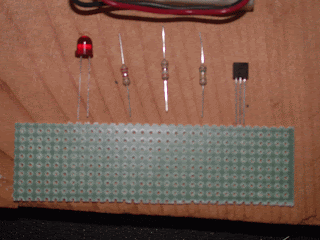Electronics 10 jfdavis
Thursday, November 21, 2013
Tuesday, January 31, 2012
Lego Hybrid Firefighting Robot
This will be my entry in the Mt. SAC / RSSC Fire Fighting competition.
It is not pure Lego: infrared filters from an old TV remote have been lightly hot-glued over the two standard NXT Light Sensors. A fruit jar lid with a wet sponge insert has been hot-glued to a small Lego part; this allows the flipper arm to bring the sponge over on top of the candle.
The port and starboard NXT Touch Sensors are multiplexed with a Mindsensors unit which then allows a free sensor port for the NXT Sonar Sensor.
A skeleton program is sort of working; it can feel its way through a maze, detect a flame, move up to the flame, and bring the sponge down on it. It doesn't succeed all of the time (hardly ever!) so I've still got a lot of programming to do.
It is not pure Lego: infrared filters from an old TV remote have been lightly hot-glued over the two standard NXT Light Sensors. A fruit jar lid with a wet sponge insert has been hot-glued to a small Lego part; this allows the flipper arm to bring the sponge over on top of the candle.
The port and starboard NXT Touch Sensors are multiplexed with a Mindsensors unit which then allows a free sensor port for the NXT Sonar Sensor.
A skeleton program is sort of working; it can feel its way through a maze, detect a flame, move up to the flame, and bring the sponge down on it. It doesn't succeed all of the time (hardly ever!) so I've still got a lot of programming to do.
Wednesday, July 13, 2011
How I built a logic probe
Today I built a logic probe. I followed the handout from Prof. Mason's Mechatronics class entitiled "Build a Logic Probe". These are the components:

Bottom view of the assembled probe. A drop of hot glue was added later to hold the power clips to the board. The probe is made from a paper clip.
Top view of the assembled probe.
This is the probe touching +5 volts (logical 1, TRUE). The LED is bright.

This is the logic probe touching nothing. The LED glows dimly..
Here the probe touches 0 volts (logical 0, FALSE, common, ground). The LED is dark.Bottom view of the assembled probe. A drop of hot glue was added later to hold the power clips to the board. The probe is made from a paper clip.
Top view of the assembled probe.
Monday, January 31, 2011
Color Sensor Breadboard Test
The video shows a breadboard with a PicAxe 14M interfaced to a color sensor. The pattern of the two orange LEDs changes according to the color of the paper placed over the detector.
Thursday, December 23, 2010
Picking up cans with Lego

While impatiently awaiting the start of Electronics 10 (Mechatronics), I began preparing for the RSSC February PUC (Pick-Up-Cans) contest. I have learned a lot, such as the fact that acrylic paint doesn't dry very fast on soda cans.
The color sensor under the claw points to the floor when the claw is open. This is to detect area colors and black boundary tape. When the claw closes around a can, the color sensor comes up to detect the color of the can.
Friday, December 10, 2010
Subscribe to:
Posts (Atom)






